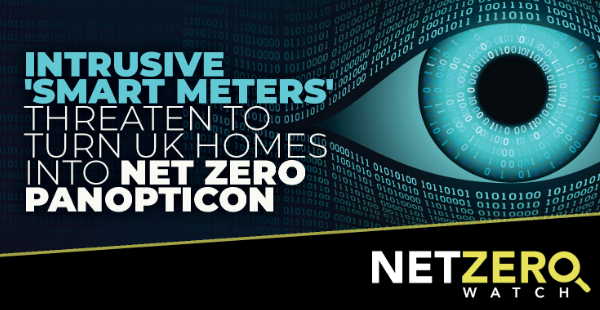From: Survival of the Richest: Smart Homes and Energy Rationing, Andrew Montford, © Copyright 2021, The Global Warming Policy Foundation, London England. Nobody but the Brits can calmly understate a disaster like this!

The Global Warming Policy Foundation (GWPF) is a UK-based think tank founded by former Conservative Chancellor Nigel Lawson with the purpose of combating what it describes as “extremely damaging and harmful policies” designed to mitigate climate change.
-
Introduction:
In 2011, the chief exective of National Grid, Steve Holliday, explained to listeners of BBC Radio 4’s Today Programme the transformation that the electricity system was about to undergo and what it would mean for ordinary householders:
“The grid is going to be a very different system in 2020, 2030. We keep thinking that we want it to be there and provide power when we need it…Families will have to get used to only using power when it [is] available, rather than constantly”.
2. The reliability of the grid
The reliability of the electricity grid depends, among other things, on two important factors. First, there must not be more demand than the cables and transformers can cope with: too much and the fuses that protect them will blow. Second, there must not be demand for more electricity than can be generated. The electricity grid can be thought of as divided into two parts: the high-voltage transmission network, and the lower-voltage distribution network, run by the “Distribution Network Operators” (DNOs) – familiar names such as Scottish and Southern Energy Networks and UK Power Networks. (Atlantic City Electric and PSG&E in United States).
3. Smart meters
Overloads on the distribution grid are most likely in the evening peak, when cookers and televisions are switched on. This peak is being accentuated as more and more electric vehicles (EVs) appear. Owners tend to switch them on in the early evening when they return from
work. The situation will become worse when heat pumps start to be installed on a large scale. Distribution Network Operators can minimise the risk of overloaded wires by shifting loads from the evening peak to the middle of the night, when demand is lower. The principal tool they expect to use to do this is the smart meter or, more precisely, price signals. Smart meters will allow domestic electricity bills to be moved to so-called ‘half-hourly settlement’, allowing customers to pay a price that varies throughout a 24-hour period – either
on a fixed schedule, like the old Economy Seven system, with low prices during the night and higher ones during the day, or priced dynamically according to the state of supply and demand. The proposals to make this happen are already being considered.
However, so-called ‘time of use’ tariffs have been available in the US for many years and have suffered from very limited take-up by consumers, who appear in general, to want to avoid the risk of very high prices at times of high demand or low renewables generation.
Smart meters are just one part of what the government and those involved in electricity supply imagine will eventually become a smart home. The vision is of a world in which smart appliances and smart meters are connected through a home area network (HAN) to a communications hub and so to planners at the Distribution Network Operators and National Grid. The equipment is already being rolled out. . .
6. Smart homes and wind lulls
As noted at the start of this paper, the need to shift load can arise in two different scenarios – when there is too much demand for the cables and transformers in the distribution grid to carry, and when there is too little electricity available to meet overall demand.
The future electricity grid is supposed to be based on wind power, and in particular offshore wind, but at times there can be little or no wind anywhere in the UK or its territorial waters. Such lulls can sometimes last three weeks or more. It is sometimes claimed that in a net zero world, the gap would be filled by zero-carbon dispatchable power – presumably gas-fired power stations with carbon capture and storage (CCS) – or electricity stores of some kind. However, after the closure of the Petra Nova pilot plant – the great white hope for the technology – CCS appears to be a dead end, and electricity storage is barely off the drawing board. Hydrogen looks impossibly expensive, and questions remain over the cost and scalability
Few commentators appear to have grasped the scale of storage that would be required to meet demand should we experience a three-week lull in the wind, as happens with some regularity. What is worse, very low temperatures tend to coincide with very low wind speeds. The low temperatures would cause a surge in demand, particularly from heat pumps, and would reduce the capacity of batteries, so there is a double whammy of rapidly rising demand and declining ability to meet it. . .
In a decarbonised grid, such ‘flexible response‘ capacity is an imperative, not an option, so in the event that consumers refused to switch off in sufficient numbers, compulsion would have to be used. In other words, their appliances would be switched off remotely. The impact on lives and businesses caused by frequent interruptions to power need hardly be mentioned. . .
As an aside, it is worth noting that the system we are about to at-
The system will be mind-bogglingly complicated, and there will therefore be a severe risk of catastrophic failure. A cyberattack could bring the whole country to a halt. But those are subjects for another day. Of course, if power is in short supply, then prices will be high, so
consumers will be incentivised to minimise consumption, but as noted above, some sources of demand, such as heating, are hard to shift, and the grid will be forced to take control. At such times, it is likely that National Grid will prevent any Electric Vehicle (EV) charging at all, and they will probably reduce heating to a bare minimum. . .
A lull in the wind lasting more than a day or two would probably lead to an emergency if it coincided with low temperatures. We have already had a taste of this new world. One UK electricity supplier, Octopus Energy, already allows its customers to adopt a pricing regime
– the ‘Agile‘ tariff – that responds to grid prices. On one day in January 2021, customers on this tariff saw an increase from 14p/kWh at breakfast time to 35p/kWh by mid-morning. Prices would have gone higher. had the tariff not included a price cap. Similarly, in Texas, where 60% of homes are electrically heated,25 some customers recently clocked up bills running into thousands of dollars in the space of a few days, when severe winter weather led to a shortage of electricity.26 More than 80 people died of the cold. It was no better in summer when, with temperatures soaring, Texas grid managers were forced to reduce electricity demand from air conditioning units by remotely raise temperature settings on consumer thermostats. . .
7. The ethical dilemmas of electricity rationing
The need to ration electricity in response to the needs of both Distribution Network Operators and National Grid will raise a host of ethical questions that will represent a minefield for everyone involved, including politicians. . .
Click Here For Link To Full Post: Survival of the Richest: Smart Homes and Energy Rationing (thegwpf.org)
“Smart Meters” will also give government the power to remotely and instantly reduce or cut off power to any homes or businesses whose owners or occupants are socially or politically “incorrect”.
Click here for link to: Intrusive ‘smart meters’ threaten to turn UK homes into Net Zero panopticon:
LibertyAndProsperity.com is a tax-exempt, non-political education organization of roughly 200 citizens who mostly live near Atlantic City, New Jersey. We formed this group in 2003. We volunteer our time and money to maintain this website. We do our best to post accurate information. However, we admit we make mistakes from time to time. If you see any mistakes or inaccurate, misleading, outdated, or incomplete information in this or any of our posts, please let us know. We will do our best to correct the problem as soon as possible. Please email us at info@libertyandprosperity.com or telephone (609) 927-7333.
If you agree with this post, please share it now on Facebook or Twitter by clicking the “share” icons above and below each post. Please copy and paste a short paragraph as a “teaser” when you re-post.
Also, because Facebook and Twitter falsely claim our posts violate their “community standards”, they greatly restrict, “throttle back” or “shadow ban” our posts. Please help us overcome that by sharing our posts wherever you can, as often as you can. Please copy and paste the URL link above or from the Twitter share button to the “comments” section of your favorite sites like Patch.com or PressofAtlanticCity.com. Please also email it to your friends. Open and use an alternate social media site like Gab.com.
Finally, please subscribe to our weekly email updates. Enter your email address, name, city and state in the spaces near the top of our home page at Homepage – Liberty and Prosperity. Then click the red “subscribe” button. Or email me at sethgrossman@libertyandprosperity.com or address below. Thanks.
Seth Grossman, Executive Director
LibertyAndProsperity.com
info@libertyandprosperity.com
(609) 927-7333

